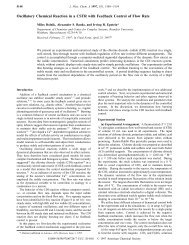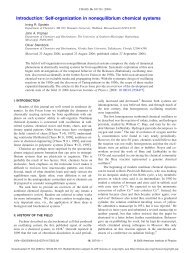Nonlinear Chemical Dynamics: Oscillations, Patterns, and Chaos
Nonlinear Chemical Dynamics: Oscillations, Patterns, and Chaos
Nonlinear Chemical Dynamics: Oscillations, Patterns, and Chaos
You also want an ePaper? Increase the reach of your titles
YUMPU automatically turns print PDFs into web optimized ePapers that Google loves.
<strong>Nonlinear</strong> <strong>Chemical</strong> <strong>Dynamics</strong> J. Phys. Chem., Vol. 100, No. 31, 1996 13135<br />
been made in clarifying the dynamic roles played by these<br />
species as well as the role of 2,4-dichlorophenol. 41,43 The<br />
essential features of the reaction are reproduced remarkably well<br />
by a simple four-variable model proposed by Olsen. 44 The<br />
feedback arises from two autocatalytic processes involving two<br />
radical species, one thought to be NAD • <strong>and</strong> the other denoted<br />
“compound III”. While the Olsen model exhibits perioddoubling<br />
cascades much like those found in the recent experimental<br />
studies, there is a need to connect the minimal model to<br />
more complete mechanistic descriptions.<br />
The “original” oscillatory reaction, the Bray reaction, 5 was<br />
perhaps an unfortunate system for inaugurating the field of<br />
nonlinear chemical dynamics. Subject to many studies over<br />
the years, its mechanismsfraught with the complexities of<br />
hydroxyl radical chemistry <strong>and</strong> interfacial transportsremains<br />
only partially understood. 45 A much younger reaction, the<br />
Briggs-Rauscher 46 reaction, seems an appropriate system for<br />
rounding out a discussion of the “early” chemical oscillators.<br />
Discovered by two high-school teachers, it was conceived by<br />
combining some of the reactants of two known oscillators, the<br />
BZ <strong>and</strong> Bray reactions. The result was an oscillatory reaction<br />
comprised of hydrogen peroxide, iodate, manganese(II), <strong>and</strong><br />
malonic acid which has been used extensively in dynamical<br />
studies <strong>and</strong> has been characterized by similar reaction mechanisms<br />
in independent investigations. 47 In the next section, a<br />
new phase in the study of oscillatory reactions is described:<br />
the systematic design <strong>and</strong> characterization of chemical oscillators.<br />
IV. New <strong>Chemical</strong> Oscillators<br />
By the late 1970s, despite considerable theoretical progress<br />
on the nature of chemical oscillation, the only known chemical<br />
oscillators were either (a) biological in origin, like the glycolytic<br />
48 <strong>and</strong> oxidase-peroxidase 39 systems; (b) discovered accidentally,<br />
like the Bray <strong>and</strong> BZ reactions; or (c) variants 26,46<br />
of those in group b. None of these routes to finding oscillating<br />
reactions offered much guidance to those seeking new systems<br />
of interest, particularly systems that might lend themselves to<br />
mechanistic study. Efforts to specify necessary <strong>and</strong> sufficient<br />
conditions for chemical oscillation or to find new chemical<br />
oscillators had proved surprisingly frustrating.<br />
An important theoretical insight was provided 49 by an analysis<br />
of a simple mathematical model consisting of two “rate”<br />
equations:<br />
dx/dt ) (-x 3 - µx + λ) - ky (2)<br />
dy/dt ) (x - y)/τ (3)<br />
Equation 2 with k ) 0 <strong>and</strong> appropriate choices for µ <strong>and</strong> λ has<br />
one unstable <strong>and</strong> two stable steady states for x; the system is<br />
bistable. The y variable provides a simple feedback that, for<br />
large enough values of the feedback parameter k <strong>and</strong> the<br />
relaxation time τ, causes the two-variable system to oscillate<br />
periodically. If we plot the behavior of the system at fixed µ<br />
<strong>and</strong> τ as a function of the parameters k <strong>and</strong> λ, we obtain the<br />
characteristic “cross-shaped phase diagram” shown in Figure<br />
3, with regions of bistability <strong>and</strong> oscillation separating regions<br />
in which only one of the steady states is stable.<br />
The behavior illustrated in Figure 3 is seen in a number of<br />
chemical systems, particularly those containing autocatalytic<br />
reactions, when the reaction is carried out in a continuous-flow,<br />
stirred tank reactor (CSTR). 50 This device, which provides the<br />
major experimental advance needed to create new chemical<br />
oscillators, offers a means of maintaining a system far from<br />
Figure 3. A schematic cross-shaped phase diagram.<br />
equilibrium by continuously supplying the reaction vessel with<br />
fresh reactants <strong>and</strong> allowing reacted material to leave so as to<br />
maintain constant volume. 51<br />
A systematic approach to designing oscillating reactions,<br />
pioneered at Br<strong>and</strong>eis in the 1980s, 52 led to the development of<br />
literally dozens of new oscillators. The technique begins with<br />
the identification of an autocatalytic reaction. Its behavior in a<br />
CSTR is then studied, <strong>and</strong> a region of bistability is sought. If<br />
such a region is found, one then seeks a feedback species, which<br />
interacts with one or more species in the bistable system in such<br />
a way as to narrow the region of bistability <strong>and</strong> on a time scale<br />
long with respect to the characteristic relaxation times of the<br />
system to its two stable steady states. This latter requirement<br />
is equivalent to choosing τ sufficiently large in the model eqs<br />
2 <strong>and</strong> 3, so that the system tends to follow the hysteresis loop<br />
of the bistable system except when the feedback causes it to<br />
jump from one of the steady states to the other. If an appropriate<br />
feedback species can be found, then one adds increasing<br />
amounts of that species to the input flow of the reactor until<br />
the bistable region narrows to a point <strong>and</strong> oscillatory behavior<br />
begins to set in.<br />
Implementation of this approach led to the first systematically<br />
designed chemical oscillator, the chlorite-iodate-arsenite<br />
system. 53 This discovery was soon followed by the development<br />
of many more oscillating reactions based upon the complex<br />
redox chemistry <strong>and</strong> autocatalytic reactions of the chlorite ion<br />
<strong>and</strong> related oxyhalogen species. The BZ reaction <strong>and</strong> its<br />
relatives, as well as several new systematically designed systems,<br />
constitute the bromate family of oscillators, <strong>and</strong> many additions<br />
to the Bray reaction have filled out the iodate group.<br />
Oxyhalogen chemistry provided the backbone to the body<br />
of chemical oscillators, but by the mid-1980s, arms <strong>and</strong> legs<br />
were beginning to sprout in the form of oscillating reactions<br />
based on the chemistry of other columns of the periodic table.<br />
The first sulfur-based oscillator, the hydrogen peroxide-sulfide<br />
reaction, 54 was soon joined by about half a dozen other such<br />
systems. Although the BZ reaction contains an organic species,<br />
usually malonic acid, the key chemistry leading to oscillation<br />
is really that of the inorganic reactants. The cobalt-catalyzed<br />
air oxidation of benzaldehyde 55 constitutes the first nonbiological<br />
oscillator in which organic reactions play the major role. The<br />
cerium ion in the BZ reaction proved to be a prototype for the<br />
role of metals in chemical oscillators until nearly the end of<br />
the decade; metal ions, if they appeared at all, served only as<br />
catalysts. Finally, the first member of a group of oscillators





